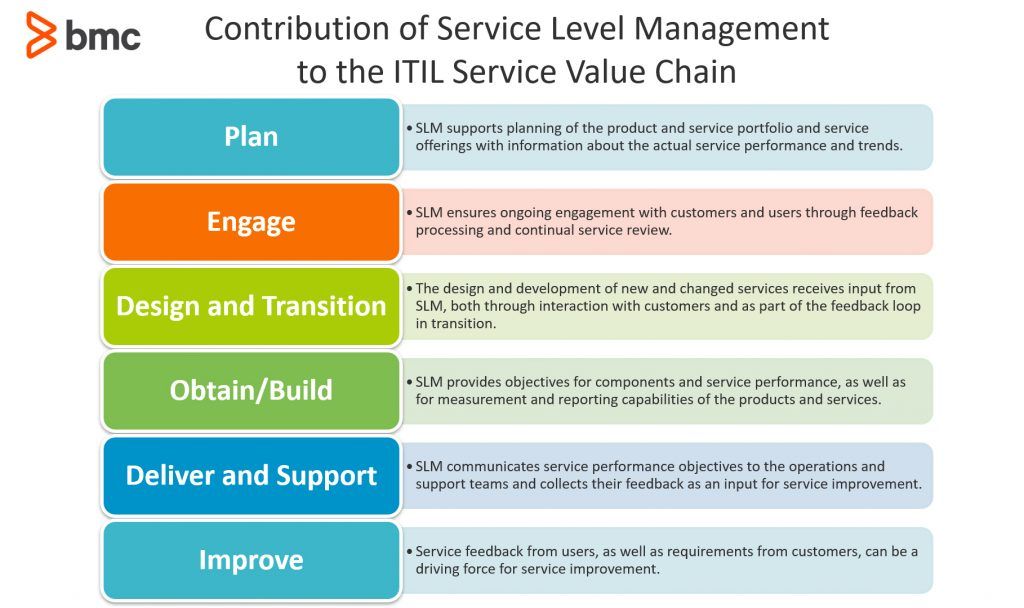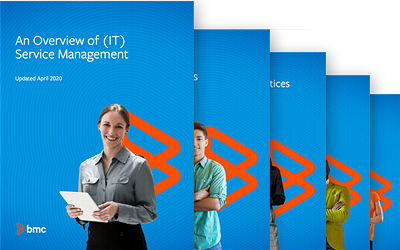The practice of Service Level Management (SLM) gives assurance to the service consumer that a provider will deliver a level of service that meets their needs. The purpose of the SLM practice is to set clear business-based targets for service performance, so that the delivery of a service can be properly assessed, monitored, and managed against these targets. SLM involves the definition, documentation, and active management of service levels.
Download Now: ITIL 4 Best Practice e-Books
These all-new for 2020 ITIL e-books highlight important elements of ITIL 4 best practices. Quickly understand key changes and actionable concepts, written by ITIL 4 contributors.
Service Level Agreements (SLAs)
An SLA is defined as a documented agreement between a service provider and a customer that identifies both services required and the expected level of service. SLAs are used to measure the performance of services from the customer’s point of view, and it is important that they are agreed in the wider business context.
Some of the key requirements for successful SLAs include:
- They must be related to a defined ‘service’ in the service catalogue. Individual metrics without a specified service context are unhelpful.
- They should relate to defined outcomes and not simply operational metrics. This can be achieved with balanced bundles of metrics, such as customer satisfaction and key business outcomes.
- They should reflect an ‘agreement’: an engagement and discussion between the service provider and the service consumer. It is important to involve all stakeholders, including partners, sponsors, users, and customers.
- They must be simply written and easy to understand and use for all parties.
The “Watermelon SLA Effect”
The ITIL 4 Foundation guide describes an effect whereby a service provider’s metrics are consistently meeting defined targets, but the customers are dissatisfied with the service received, and also frustrated that the provider doesn’t notice this. Usually this happens when the service provider misses out on significant business functionalities and outcomes which are important to the consumer. Therefore there is a mismatch between the customer’s perception of the service and the provider’s view of service performance.
For example, a service provider might report 99.9% uptime; however the 0.01% downtime happened at the most critical time for the customer’s business causing significant damage to financials and reputation, yet the service provider downplays the effect of that particular downtime. In this particular example, the service provider is focused more on availability metrics rather than customer experience.
The result is that while the service provider’s dashboards might visualize their performance as green, the customer’s experience is more akin to “red status”. The name “watermelon effect” is invoked by this color effect: like a watermelon, the SLA is green on the outside, and red on the inside.
SLM needs to identify metrics and measures that are a truthful reflection of the customer’s actual experience and level of satisfaction with the whole service. And because these will vary across organizations, the only way to learn what these are is to find out directly from customers.
SLM: Engage and Listen
In order to be aligned to customer outcomes and expectations, SLM requires focus and effort to engage and listen to the requirements, issues, concerns, and daily needs of customers:
- Engagement is needed to understand and confirm the actual ongoing needs and requirements of customers, not simply what is interpreted by the service provider or has been agreed several years before. ITIL4 refers to value as being co-created, since it needs the input and validation of customers.
- Listening is important as a relationship-building and trust-building activity, to show customers that they are valued and understood. This helps to move the provider away from always being in ‘solution mode’ and to build new, more constructive partnerships. Each customer is unique, and the service provider must not have a one-size-fits-all approach.
The activities of engaging and listening provide a great opportunity to build improved relationships and to focus on what really needs to be delivered. They also give service delivery staff an experience-based understanding of the day-to-day work that is done with their technology, enabling them to deliver a more business-focused service. When the customer is engaged and listened to, they feel valued and their perception of the service and service management activities improves.
SLM Information Sources
SLM involves collating and analysing information from a number of sources including:
- Customer Engagement: This involves initial listening, discovery, and information capture on which to base metrics, measurement, and ongoing progress discussions through simple open ended questions on topics such as the what the customer uses the service for, the expected outcomes and how the service provider can help achieve the outcomes.
- Customer Feedback: This is ideally gathered from a number of sources, both formal and informal, including satisfaction surveys and key business-related measures such as SLAs and KPIs.
- Operational Metrics: These are the low-level indicators of various operational activities and may include measures such as availability, response times, resolution times, and processing times.
- Business Metrics: These can be any business activity that is deemed useful or valuable by the customer and used as a means of gauging the success of the service. Examples inlclude customer registration, billing, and transaction completion.
Once this feedback is gathered and collated for ongoing review, it can be used as input to design suitable measurement and reporting models and practices.
Required SLM Skills and Competencies
The skills and competencies for SLM include relationship management, business liaison, business analysis, and commercial/supplier management due to the emphasis on engagement with the customer and all stakeholders involved in service management. Therefore, a holistic approach which focuses on the whole service and not simply its constituent parts is required. Simple individual metrics (such as percentage system availability) should not be taken to represent the whole service level, rather a view that incorporates customer perception and business outcomes must be the standard approach to SLM.
Contribution of Service Level Management to the Service Value Chain
Service Level Management is involved in all service value chain activities (mainly plan and engage) as shown below:
| Plan | SLM supports planning of the product and service portfolio and service offerings with information about the actual service performance and trends. |
| Engage | SLM ensures ongoing engagement with customers and users through feedback processing and continual service review. |
| Design and Transition | The design and development of new and changed services receives input from SLM, both through interaction with customers and as part of the feedback loop in transition. |
| Obtain/Build | SLM provides objectives for components and service performance, as well as for measurement and reporting capabilities of the products and services. |
| Deliver and Support | SLM communicates service performance objectives to the operations and support teams and collects their feedback as an input for service improvement. |
| Improve | Service feedback from users, as well as requirements from customers, can be a driving force for service improvement. |

ITIL® is a registered trade mark of AXELOS Limited. IT Infrastructure Library® is a registered trade mark of AXELOS Limited.








